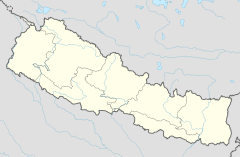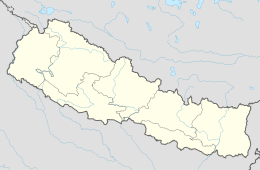
Back মুক্তিনাথ Bengali/Bangla मुक्तिनाथ DTY मुक्तिनाथ Hindi मुक्तिनाथ MAI मुक्तिनाथ Nepali Templo de Muktinath Portuguese Муктинатх Russian முக்திநாத் Tamil ముక్తినాథ్ Tegulu มุกตินาถ Thai
This article has multiple issues. Please help improve it or discuss these issues on the talk page. (Learn how and when to remove these template messages)
|
| Muktinath Temple | |
|---|---|
 Muktinath Temple with Dhaulagiri Himalaya in the background | |
| Religion | |
| Affiliation | Hinduism, Buddhism |
| District | Mustang District |
| Deity | Vishnu |
| Features |
|
| Location | |
| Location | Muktinath (Dhawalagiri) |
| Country | Nepal |
Location in Nepal | |
| Geographic coordinates | 28°49′01″N 83°52′18″E / 28.816854°N 83.871742°E |
| Architecture | |
| Type | Pagoda |
| Elevation | 3,762 m (12,343 ft) |
Muktinath is a Vishnu temple located in Mustang, Nepal. The temple is sacred to both Hindus and Buddhists whom they worship as an abode of Hindu deity Vishnu and Buddhist deity Avalokiteśvara respectively.[1][2] Located in the Muktinath valley at the foot of the Thorong La mountain pass, It is one of the world's highest temples at an altitude of 3,800 meters. The temple is given a status of one of the 108 Divya Desams of Hinduism and the only Divya Desam located outside India. It is also one of the 51 Shakti Pitha, associated with the head of goddess Sati. [3] The temple complex is known as Mukti Kshetra, which literally means "the place of liberation (moksha)" and is one of the Char Dham in Nepal.[4]
For Buddhists, Muktinath is an abode of dakinis - goddesses known as Sky Dancers and is considered one of the twenty-four Tantric places. Tibetan Buddhists call it Chumig Gyatsa, which in Tibetan means "Hundred Waters" and the murti is revered as a manifestation of Avalokiteśvara, who embodies the compassion of all Buddhas.[5]

- ^ "Brief history of Muktinath-Chumig Gyatsa at the Annapurna Circuit - Nepal". muktinath.org. Retrieved 2024-06-28.
- ^ "Muktinath Temple". templesofindia.co. 2024-04-13. Retrieved 2024-06-28.
- ^ Alightindia. "Muktinath Temple - History, information & Temple timings". Muktinath Temple - History, information & Temple timings. Retrieved 2024-06-28.
- ^ "Nepal's Top Pilgrimage and Holy Sites – The Abode of Spirituality". Nepali Sansar. 2019-03-30. Retrieved 2020-12-14.]
- ^ Zurick, David (2006). Illustrated Atlas of the Himalayas. Lexington: University Press of Kentucky. p. 153.

